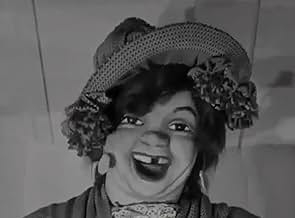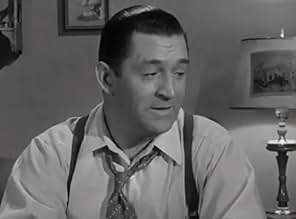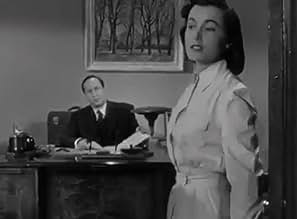NOTE IMDb
6,2/10
899
MA NOTE
Ajouter une intrigue dans votre langueMany interested parties are after the loot from a factory payroll heist but the mobster who hid it has amnesia after undergoing experimental brain surgery in the prison hospital.Many interested parties are after the loot from a factory payroll heist but the mobster who hid it has amnesia after undergoing experimental brain surgery in the prison hospital.Many interested parties are after the loot from a factory payroll heist but the mobster who hid it has amnesia after undergoing experimental brain surgery in the prison hospital.
- Réalisation
- Scénario
- Casting principal
Chris Alcaide
- Pursuing Detective
- (non crédité)
Fred Aldrich
- Cop
- (non crédité)
Leonard Bremen
- Guard at Clinic
- (non crédité)
Paul Bryar
- Freddie - Bartender
- (non crédité)
Sayre Dearing
- Patient in Wheelchair at Clinic
- (non crédité)
Frank Fenton
- Detective Driver
- (non crédité)
John Harmon
- Herman
- (non crédité)
Mary Alan Hokanson
- Nurse
- (non crédité)
Shepard Menken
- Interne
- (non crédité)
Howard Negley
- Detective
- (non crédité)
Frank O'Connor
- Gate Guard
- (non crédité)
Avis à la une
Edmond O'Brien has a severe case of retrograde amnesia, but he didn't contract it in the Pacific. He's a robber who got away with $130,000 in a Christmas Eve heist, was convicted and served his time. But he'll get a second chance if he submits to an operation to excise the criminal portion of his brain. Understandably, he's conflicted, and when they move it up from the scheduled day he balks: `I was born on a Monday. I may as well go on one like dirty laundry.' But the operation proves a stunning success, so delicate that it erases all memories of his past life but leaves him with a perfect command of American slang.
But the placid life he leads at the sanitarium pruning hedges and daubing canvases comes to an abrupt halt when he's kidnaped by his old gang, now led by Ted De Corsia. They want the money, which was never recovered; so does an implacable Javert of an insurance investigator. Even his old girlfriend (Audrey Totter) sees him only as a ticket to the high life, until she falls for the new, improved O'Brien and renounces her grasping ways. (The often ill-used Totter shines here, especially on a martini bender when she asks the bartender, `Oh, Fred, what do you do when you hate yourself?')
Odd clues begin to surface from O'Brien's troubled nightmares, however, leading him and Totter (with the rest of the cast plus the police in pursuit) to claim a parcel left at an amusement park. And this is the big set-piece of the movie, originally released in 3-D. Cars come whooshing around the curves and down the dips of a roller coaster while pitched battles are being fought on the tracks. Watching these 3-D movies now is like drinking soda that's gone flat: All the ingredients are there but the sparkle's gone. But in their endearingly gimmicky way, they evoke their era, as do the flats equipped with party lines and furnished with lampshades bearing reproductions of paintings. Man in the Dark's too short, and needs an extra layer of complexity. But there's still a bit of fizz left in it.
But the placid life he leads at the sanitarium pruning hedges and daubing canvases comes to an abrupt halt when he's kidnaped by his old gang, now led by Ted De Corsia. They want the money, which was never recovered; so does an implacable Javert of an insurance investigator. Even his old girlfriend (Audrey Totter) sees him only as a ticket to the high life, until she falls for the new, improved O'Brien and renounces her grasping ways. (The often ill-used Totter shines here, especially on a martini bender when she asks the bartender, `Oh, Fred, what do you do when you hate yourself?')
Odd clues begin to surface from O'Brien's troubled nightmares, however, leading him and Totter (with the rest of the cast plus the police in pursuit) to claim a parcel left at an amusement park. And this is the big set-piece of the movie, originally released in 3-D. Cars come whooshing around the curves and down the dips of a roller coaster while pitched battles are being fought on the tracks. Watching these 3-D movies now is like drinking soda that's gone flat: All the ingredients are there but the sparkle's gone. But in their endearingly gimmicky way, they evoke their era, as do the flats equipped with party lines and furnished with lampshades bearing reproductions of paintings. Man in the Dark's too short, and needs an extra layer of complexity. But there's still a bit of fizz left in it.
I watched most of Man in the Dark without realising it was originally shot in 3D. At first I thought I was watching a lost Fritz Lang classic---extreme closeups, odd points of view, shattering glass---until I remembered the film had been directed by, ahem, Lew Landers. Now nothing against old Lew, he delivered many a fine B picture, but Man in the Dark doesn't look like your typical Columbia programmer. It's black and white take on the 3D process is more noir than you'd expect and it obviously helped to have Floyd Crosby behind the camera. Edmond O'Brien and Audrey Totter are good as always, overcoming a pretty hackneyed script that is the film's major shortcoming. Worth seeing for the dream sequence alone, where O'Brien is pursued by policemen in bumper cars!!
Edmond O'Brien played in quite a few film noir pictures. And, interestingly, they all seem to be excellent...even "Man in the Dark" which you would expect to be a bad picture even WITH O'Brien. Why? Because the film was cranked out in only 11 days AND because there were a lot of cheap 3D tricks in the picture...yet it still turned out to be very, very good. So why would the studio do this in 11 days? Apparently, 3D movies were brand new and they wanted to be the first major studio to make a 3D picture....yet, amazingly, the film doesn't seem rushed or second-rate!
When the story begins, a prisoner (O'Brien) is about to undergo some surgery. When he awakens, he has no memory of who he was and is christened 'Steve Rawley' by the doctors. Unfortunately, his old gang doesn't know about the purpose of the surgery--they just know they've got to kidnap him and tell them where he stashed the loot from a robbery. But he really does NOT know where it is nor who he was. His only clues are strange dreams he's been having. Could they point him to the right direction before the gang decides just to kill him and be done with it?
As usual, Edmond O'Brien is great. He's tough, mouthy and just the sort of ugly mug you'd expect in a noir picture. And, having Audrey Totter and Ted de Corsia in supporting roles sure didn't hurt! Overall, a nice viewing experience...even with all the 3D gimmicks and use of rear projection towards the end (which I normally hate because it looks so fake).
When the story begins, a prisoner (O'Brien) is about to undergo some surgery. When he awakens, he has no memory of who he was and is christened 'Steve Rawley' by the doctors. Unfortunately, his old gang doesn't know about the purpose of the surgery--they just know they've got to kidnap him and tell them where he stashed the loot from a robbery. But he really does NOT know where it is nor who he was. His only clues are strange dreams he's been having. Could they point him to the right direction before the gang decides just to kill him and be done with it?
As usual, Edmond O'Brien is great. He's tough, mouthy and just the sort of ugly mug you'd expect in a noir picture. And, having Audrey Totter and Ted de Corsia in supporting roles sure didn't hurt! Overall, a nice viewing experience...even with all the 3D gimmicks and use of rear projection towards the end (which I normally hate because it looks so fake).
Edmond O'Brien stars in "Man in the Dark," a 1953 film also starring Audrey Totter. O'Brien plays Steve Rawley, a prisoner who undergoes experimental surgery that's supposed to erase the criminal elements of his brain. It also wipes his memory of past events.
Unfortunately Steve and some other thugs committed a big robbery and Steve hid the money. Now that he has no memory, he doesn't know where he put it. His old gang kidnaps him and tries to find out his hiding place. His old girlfriend Peg (Totter) is around, and she wants him to forget the whole thing and go away with her.
Steve starts remembering things in the form of bizarre dreams. He and Peg attempt to follow the clues in the dreams to track down the money.
Edmond O'Brien made a lot of these B films for Columbia. This one is no better or worse than many of them. The last part of the film takes place in an amusement park, and it's very good.
Originally this film was in 3-D, and like some other films, it was filmed in the seen-better-days area of Ocean Park near Venice, CA. I always like seeing the old LA, and this film has lots of shots of it.
I had one major problem with this film, and it's a major plot hole. If you had stolen a lot of money and hidden it, why would you agree to a surgery that is going to clean out your memory so that you don't remember where you hid it?
I don't know the answer.
Unfortunately Steve and some other thugs committed a big robbery and Steve hid the money. Now that he has no memory, he doesn't know where he put it. His old gang kidnaps him and tries to find out his hiding place. His old girlfriend Peg (Totter) is around, and she wants him to forget the whole thing and go away with her.
Steve starts remembering things in the form of bizarre dreams. He and Peg attempt to follow the clues in the dreams to track down the money.
Edmond O'Brien made a lot of these B films for Columbia. This one is no better or worse than many of them. The last part of the film takes place in an amusement park, and it's very good.
Originally this film was in 3-D, and like some other films, it was filmed in the seen-better-days area of Ocean Park near Venice, CA. I always like seeing the old LA, and this film has lots of shots of it.
I had one major problem with this film, and it's a major plot hole. If you had stolen a lot of money and hidden it, why would you agree to a surgery that is going to clean out your memory so that you don't remember where you hid it?
I don't know the answer.
If you approach this movie with the expectation that it's a noir crime classic, you'll be disappointed. But if you come to this film for what it was at the time -- the first 3-D movie barely over an hour long, that was rushed through production to beat out a better-known movie to theater audiences -- a low budget but not cheap crime noir with snappy, clever dialogue that Tarantino wishes he wrote -- a black/white crime caper that skillfully blends backlot scenery (the rooftop chase scene must have been literally on top of the actual movie studio soundstages and offices) with Los Angeles street scenery, with genuine 1953-Lost Angeles street scenes, fashions and architecture -- all topped off with solid acting from star and superlative actor O'Brien, supported by journeymen character co-stars -- and for dessert -- the first glimpse of action choreography designed specifically to showcase the brand new 3-D technology (something we still see too much of in modern 3-D flix) -- then what we have is a movie whose parts are better than the sum total.
Oh, and did I mention the crazy fun dialogue?
If this movie is watched with an eye toward film history, then it goes from a rating of 6, to a rating of 8. This movie is a remake of a 1930s plot, then it was remade as a TV episode. Expect to see it again someday in a modern movie or tv show. It's a solid plot with all kinds of fun possibilities.
Oh, and did I mention the crazy fun dialogue?
If this movie is watched with an eye toward film history, then it goes from a rating of 6, to a rating of 8. This movie is a remake of a 1930s plot, then it was remade as a TV episode. Expect to see it again someday in a modern movie or tv show. It's a solid plot with all kinds of fun possibilities.
Le saviez-vous
- AnecdotesThe first 3-D feature ever released by a major American studio. L'Homme au masque de cire (1953) went into production first, but Columbia rushed "Man in the Dark" - shooting it in a mere 11 days - to get it into theaters just days before "Wax" opened. (Bwana le diable (1952) preceded both of them, but United Artists was not considered a major studio in the early 1950s.)
- GaffesDuring the chase when Steve is abducted, one of the crooks leans out of the car and fires nine shots at the cops from a six-shot revolver.
- Citations
[first lines]
Cop: You get prettier every day.
Nurse Receptionist: Tell me about the beauty contest you won.
- Versions alternativesOriginally released in 3D, in prints that were sepia-toned.
- ConnexionsFeatured in TJ and the All Night Theatre: The Man Who Lived Twice (1979)
Meilleurs choix
Connectez-vous pour évaluer et suivre la liste de favoris afin de recevoir des recommandations personnalisées
Détails
- Durée1 heure 10 minutes
- Rapport de forme
- 1.37 : 1
Contribuer à cette page
Suggérer une modification ou ajouter du contenu manquant

Lacune principale
By what name was J'ai vécu deux fois (1953) officially released in India in English?
Répondre


































